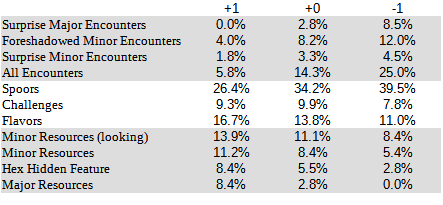Wilderness Discovery Check
Back from the dead! I'm fixin' to finally run a wilderness hexcrawl that I'm very excited about, and am refining some procedures prior to play. I figured I'd document some of the prep here, in case it's useful to others!
After looking at some great examples of modified encounter checks but not quite finding what I wanted, I decided to incorporate some of the general ideas and formulate my own mechanic. The Hazard System and the Underclock were large inspirations to this.
Goals: Allow for surprises, both good and bad. Sometimes create suspense. Have no "null" results. Have higher results be better, to allow modifiers to the roll depending on conditions.
Roll 2d6:
[Spoor (SP) starts at 0]
2: Bigger Encounter (surprise). Reset SP to 0
3: Regular Encounter. Reset SP to 0
4: SP > 0? Encounter. Else, SP+1
5: SP > 1? Encounter. Else, SP+1
6: SP > 2? Encounter. Else, SP+1
7: SP > 0? SP+1. Else, Challenge
8: Flavor, SP-1
9: Minor Resource (if looking). Else, Flavor. SP-1
10: Minor Resource, SP-1
11: Hex Hidden Feature, SP-1
12: Major Resource, SP-1
Bigger/Regular Encounter: I have my critter encounter table organized by increasing threat. When rolling Bigger, I'll add 1 to the roll, biasing the result a bit. May adjust the bonus to the roll later. The Spoor is unrelated to this roll, so it'll always be a surprise. Can only foreshadow one thing at a time...
Spoor (SP): Each time you increase Spoor by 1, do some foreshadowing of the upcoming critter encounter. Marked territory, molts, half-finished meals, scat, etc. The first time you roll this, you'll have to roll your Regular Encounter as well to know what to foreshadow. This also serves as a counter - the higher the count (up to 3), the more likely the next roll will be the foreshadowed encounter. This is the part that is meant to increase suspense. It's never guaranteed to happen though - sometimes the trail will go cold.
Challenge: Some obstacle or difficulty the party must face - crevasse blocking the way, leeches in the bog, etc.
Flavor: Some set dressing, showing the interesting/distinct part of this region. Alternately, a region-specific event (like periodic earthquakes in the domain of a great slumbering wyrm).
Minor Resource: Such as foraged foods, herbs, etc. If keeping an eye out for such things as a travel action, this is more likely to occur.
Hex Hidden Feature: Sometimes you'll stumble on the hidden thing in a hex without having to search. This is assuming you have hidden aspects to a hex (like the Landmark, Hidden, Secret structure).
Major Resource: Such as a visible vein of cassiterite, huge grove of nut trees, magical altar, etc. If this hex already has one discovered, replace with Flavor.
I ran a simulation script in Python to get a feel for the likelihood of certain results. Here's the approximate percentages (based on a run of 100k rolls each) for rolling with +1, no modifier, and -1:
When rolling at +0, times it got up to:Spoor 1: 19.5%
Spoor 2: 10.3%
Spoor 3: 3.6%
Spoor 4+: 0.8%
This feels pretty good to me. Encounter chance is still fairly close to 1 in 6 normally (14.3 vs 16.6%), but encounters will be foreshadowed more often than not, creating some suspense. When rolling normally, about half of rolls will result in either encounters or spoor. Adding a +1 or -1 to the roll makes a big difference, reducing to a bit less than half chance and almost doubling the chance respectively. I doubt I'll add larger modifiers except in very unusual cases. Overhead is pretty minimal, it just requires keeping a small running tally.



Comments
Post a Comment